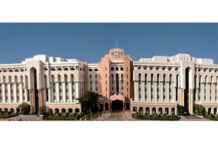Port development, an integral part of Oman’s diversification programme, is going to redraw the country’s logistics map.
Oman government has announced that commercial activities at Port Sultan Qaboos (PSQ) will be completely shifted to Sohar by the end of August this year, in an attempt to further improve the attraction of Muscat as a destination for leisure tourists coming by luxury cruise vessels from across the world. While container ships, general cargo vessels and ships carrying vehicles will be shifted to Sohar, Muscat port will continue to allow vessels carrying grains, cement and bitumen. In line with the government move, several major shipping lines, including Maersk Line, Safmarine, Hyundai Merchant Marine and Oman Container Lines, have already announced the timelines for shifting to Sohar, even as shipping agents have already set up their bases at the industrial port. Muscat port will get a makeover with the expected development of high-end marina and hotel facilities, in its new focus on tourism and leisure destination. The development will follow the blueprints of already established and historic ports such as Cape Town, London and New York.
In fact, Sohar Port and Freezone has seen $15 billion worth of development in a bid to transform the area into a commercial hub, including an expected rail network to enhance transport links. The Oman International Container Terminal at Sohar port has increased container capacity to 1.5 million twenty foot equivalent units(TEUs). The on-going multi-billion investment in port development is also expected to help Oman to attract more and more transshipment trade, in a bid to make the country a regional hub. Duqm Port, which started operations last year for receiving specialised project cargo for oil and gas industry, is investing heavily on all support infrastructure, gate, offices, roads and utilities. It may take more than a year for the port authorities to go for full-fledged operation sometime in 2015, after completing some of the remaining projects. The whole Duqm port development programme was divided into seven packages. The early operations phase centres on a 300-metre long quay wall, which is part of a 2.2-kilometre-long commercial quay, whose substructure is substantially complete. The commercial quay is dividend into three main areas – 300 metres of cargo terminal, 1.6 kms of container terminal and 300 metres for a dedicated break bulk terminal for mining and mineral companies.
Oman has also signed a final concession agreement with the Consortium Antwerp Port (CAP) to operate, develop and manage the Port of Duqm Company (PDC) and its industrial land for the next 28 years. With this pact, PDC — a 50:50 joint venture between CAP and Oman government — will have the overall responsibility for further development, management and commercialisation of Duqm Port facilities, including the industrial zone. The major potential users of Port of Duqm can be divided into three major groups – companies engaged in oil field development (for brining project cargos like rigs, pipelines and supplies), those in container business and mineral and mining companies.
Apart from Duqm, planned expansion programme is at an advanced stage of completion at Salalah port. The Netherland-based marine contractor Archirodon Construction Overseas is building a general cargo terminal, along with a liquid jetty. The general cargo terminal will meet the growing demands for increased economic activity in Dhofar region and attract foreign investments to Salalah.
The project will increase cargo handling capacity to 20 million tonnes per annum (mtpa) of dry bulk commodities and over six million tonnes of liquid products, in comparison to the port’s present cargo handling capacity of 6.5 mtpa. Main commodities driving the growth of the general cargo business are exports of locally available limestone, gypsum and cement as well as plastics and other bulk commodities. The expansion of the general container terminal covers the construction of an additional 1,200 metres of multi-purpose berth with 18 metres of draft and includes liquid commodities loading facilities. The proposed liquids terminal will add to the port’s ability to handle a number of liquids including methanol, fuel, mono-ethylene glycol, and caustic soda, enabling Port of Salalah to become a premier liquid bulk hub in the region.Once completed, Port of Salalah will boast a world-class general cargo terminal to complement its container terminal. This combination of facilities utilising the strategic spot that Salalah occupies and a well functioning free zone creates the ‘Salalah Hub’, ready to serve the local, regional, and global business interests.






